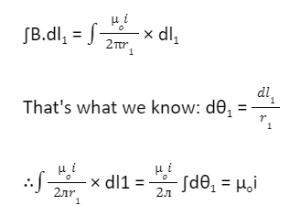Ampere’s law in electromagnetism helps define the relativity between the electromagnetic field and electric flow. According to this law, the size of the electric flow is relative to the field generated by the electric flow itself, with a consistent proportionality equivalent to the permeability of free space.
This law permits us to keep an appropriate extension to satisfy the hole between power and attraction. Using this law, a numerical connection between field and electric flow can be obtained. Ampere’s law gives the method for computing the magnetic field generated because of the aftereffect of an electric flow in a wire of any shape.
Definition of Ampere’s law
Ampere’s law can be utilised to relate electric current passing through a closed loop to the magnetic field spread around that loop. This law was named after the researcher Andre Marie Ampere. After going through different trials, Ampere came up with the results that explain the forces on wires when they are injected with a current. This law includes an understanding of both electric and magnetic fields.
Clarification of this law expresses that the lines of the field around the path of electricity will be related to the magnitude of the flow of electricity on the way. Another scientist named Maxwell has explained it in more detail, and his definition determines the magnetic field or current associated with the current and magnetic field.
The basic type of law is as beneath:
∮Bds = μ0I
Where μ0 is the permeability of free space, and ‘I’ is current.
Likewise, in summary,
BΔS = μ0I
Characteristics of Ampere’s law
One thing that Ampere’s law considers is that the flow of the current needs to be consistent. That means the flow needs to be along the field lines and doesn’t change with time. Likewise, only flows that cross the region inside the path should be considered, as they will be bound by the magnetic field. The current flow needs to be taken with their arithmetic sign according to their direction. The right-hand rule of the magnetic field can help in deciding the direction and sign of the flow of current. If the magnetic field is typical to the chosen manner at any time, the absolute magnetic field will be 0. Ampère’s law will also come in handy for calculating the magnetic fields of current dispersions with a high level of precision.
This law depends on the understanding that the closed circle comprises little natural pieces of conductors. This closed circle can also be called the Amperian circle.
Further, this essential will be equivalent to the augmentation of net current going through this close circle and the porousness of free space (oi)
Evidence 1 (Regular Loop):
To demonstrate
∫B.dl = μoi
Let’s start with the LHS. At some point, it can be found that the angle between dl and B is 0°.
expression of the magnetic field because of the long conductor will be
B = μoi/(2πr)
Additionally, the shape of the circle will be formed by these small components, whose perimeter will be (2πr):
∫ dl = 2πr
Presently, putting the worth of B and ∫ dl in the situation, we get:
B∫ dl = μoi/(2πr) × 2πr = μoi
∴∫B.dl = μoi
Evidence 2(Irregular curl):
To demonstrate: ∫B.dl = μoi
Beginning from the left-hand side:

∫B.dl = μoi
From the above two expressions, one thing can be said: the magnetic field at a point doesn’t rely upon the state of the Amperian circle. And the magnitude of the generated magnetic field will be the same at every point of the circle.
The magnitude of the magnetic field anytime on the Amperian circle is unrelated to the circle framed by the wire going through the middle, and the direction can be determined by the right-hand thumb rule. According to this rule, if we hold the thumb and the other four fingers perpendicular to each other, and the direction of the wire containing the flow of current is in the direction of the thumb, the rotation of the four fingers will represent the movement of the magnetic field.
Importance and applications of Ampere’s law
Ampere’s law has numerous functional applications. We can find some of the applications in electromagnets, engines, generators, changes, etc. In numerous computations, Ampere’s law works on the cycle by utilising a specific balance. In general, usage of Ampere’s law can be found as follows:
This law can be used in deciding the existence of magnetic force or field.
This law can be used in determining the presence of a magnetic field inside a toroid.
This law can be used to decide the existence of the magnetic field generated by any long current conveyor directed to a chamber.
Decide the magnetic field inside the guide.
This law can track the direction and magnitude of forces between two wires conducting current.
Below are the examples we face in our daily lives and combine Ampere’s law in their work.
Solenoid
Straight wire
Thick wire
Cylindrical conductor
Toroidal solenoid
Conclusion
In this article, we have discussed what Ampere’s law is. It is a law we use in electromagnetism, and it states that the size of the electric flow is relative to the field generated by the electric flow itself, with a consistent proportionality equivalent to the permeability of free space. We have also discussed the equation of Ampere’s law and its characteristics and applications in daily life.
 Profile
Profile Settings
Settings Refer your friends
Refer your friends Sign out
Sign out






